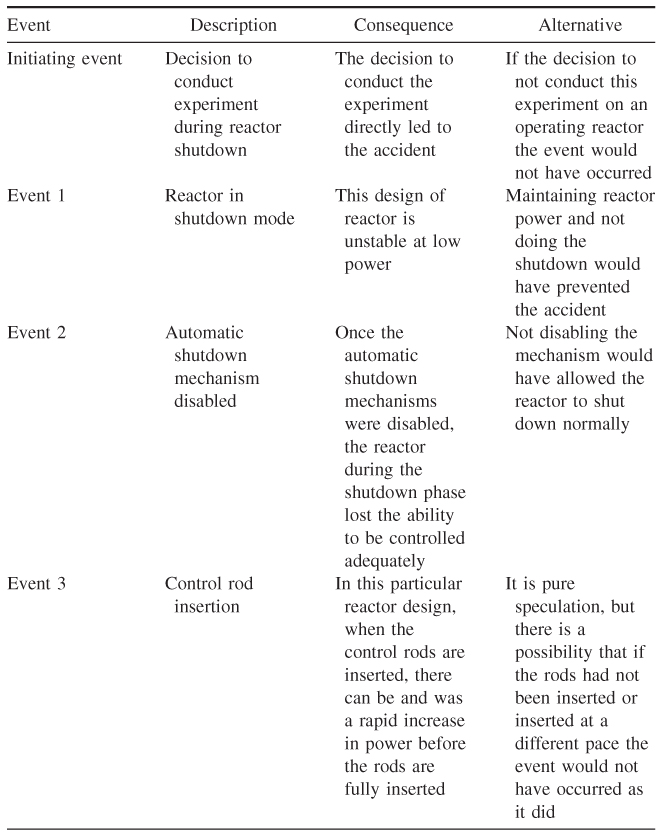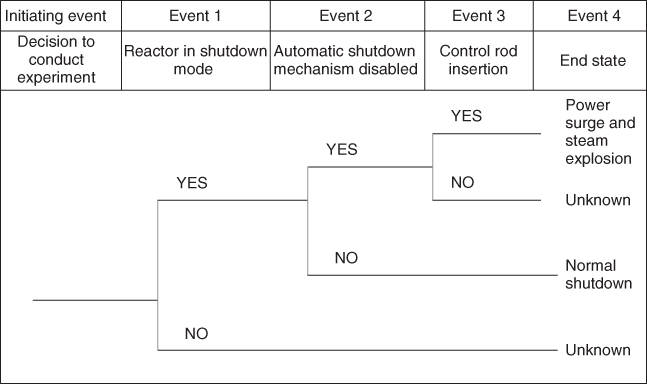12.3 Case Study: Chernobyl
On 25 April, 1986, prior to a routine shutdown, the reactor crew at Chernobyl 4 began preparing for an experiment to determine how long turbines would spin and supply power to the main circulating pumps following a loss of main electrical power supply. This test had been carried out at Chernobyl the previous year, but the power from the turbine ran down too rapidly, so new voltage regulator designs were to be tested (6).
Multiple operator actions, including the disabling of automatic shutdown mechanisms, preceded the attempted experiment on the morning of April 26. By the time that the operator began to shut down the reactor, it was in an extremely unstable condition. The design of the control rods caused a dramatic power surge as they were inserted into the reactor.
The interaction of extremely hot fuel with the cooling water led to fuel disintegration, along with rapid steam production and an increase in reactor pressure. The design characteristics of the reactor were such that substantial damage to even three or four fuel assemblies could—and did—result in the failure of the reactor vessel. Extreme pressure in the reactor vessel caused the 1000 ton cover plate of the reactor to become partially detached. The fuel channels were damaged and the control rods jammed, which by that time were only halfway down. Intense steam generation then spread throughout the entire core. The steam resulted from water being dumped into the core because of the rupture of the emergency cooling circuit. A steam explosion resulted and released fission products to the atmosphere. A second explosion occurred a few seconds later that threw out fuel fragments and blocks of hot graphite. The cause of the second explosion has been disputed by experts, but it is likely to have been caused by the production of hydrogen from zirconium–steam reactions.
Two workers died as a result of these explosions. The graphite (about a quarter of the 1200 tons of it was estimated to have been ejected) and fuel became incandescent and started a number of fires, causing the main release of radioactivity into the environment. A total of about 14 EBq (14 × 1018 Bq) of radioactivity was released, over half of it being from biologically inert noble gases.
About 200–300 tons of water per hour was injected into the intact half of the reactor using the auxiliary feed water pumps. However, this was stopped after half a day because of the danger of it flowing into and flooding units 1 and 2. From the second to tenth day after the accident, some 5000 tons of boron, dolomite, sand, clay, and lead were dropped on to the burning core by helicopter in an effort to extinguish the blaze and limit the release of radioactive particles.
It is estimated that all of the xenon gas, about half of the iodine and cesium, and at least 5% of the remaining radioactive material in the Chernobyl 4 reactor core (which had 192 tons of fuel) was released in the accident. Most of the released material was deposited close to the reactor complex as dust and debris. Lighter material was carried by wind over the Ukraine, Belarus, Russia, and to some extent over Scandinavia and Europe.
The casualties included firefighters who attended the initial fires on the roof of the turbine building. All these were put out in a few hours, but radiation doses on the first day were estimated to be up to 20,000 mSv, causing 28 deaths—6 of which were firemen—by the end of July 1986.
The Soviet Government made the decision to restart the remaining three reactors. To do so, the radioactivity at the site would have to be reduced. Approximately 200,000 people (“liquidators”) from all over the Soviet Union were involved in the recovery and cleanup during the years 1986 and 1987. Those individuals received high doses of radiation, averaging around 100 mSv. Approximately 20,000 of the liquidators received about 250 mSv and a few received 500 mSv. Later, their numbers swelled to over 600,000 but most of them received only relatively low radiation doses.
Causing the main exposure hazard were short-lived iodine-131 and caesium-137 isotopes. Both of these are fission products dispersed from the reactor core, with half-lives of 8 days and 30 years, respectively (1.8 EBq of I-131 and 0.085 EBq of Cs-137 were released). About 5 million people lived in areas contaminated (above 37 kBq/m2 Cs-137), and about 400,000 lived in more contaminated areas of strict control by authorities (above 555 kBq/m2 Cs-137).
Approximately 45,000 residents were evacuated from within a 10 km radius of the plant, notably from the plant operators' town of Pripyat on May 2 and 3. On May 4, all those living within a 30 km radius—a further 116,000 people from the more contaminated area—were evacuated and later relocated. Approximately 1000 of those evacuated have since returned unofficially to live within the contaminated zone. Most of those evacuated received radiation doses of less than 50 mSv, although a few received 100 mSv or more.
Reliable information about the accident and the resulting contamination was not made available to affected people for about 2 years following the accident. This led the populace to be distrustful of the Soviet Government and led to much confusion about the potential health effects. In the years following the accident, a further 210,000 people were moved into less contaminated areas, and the initial 30 km radius exclusion zone (2800 km2) was modified and extended to cover an area of 4300 km2. This resettlement was owing to the application of a criterion of 350 mSv projected lifetime radiation dose, although, in fact, radiation in most of the affected area (apart from half a square kilometer) fell rapidly after the accident so that average doses were less than 50% above normal background of 2.5 mSv/year.
Recent studies have found that the area surrounding the reactors is recovering, although background radiation levels are approximately 35 times normal background level (7). In fact, in 2010, the area surrounding the reactor site was opened for tourism (8).
The consequences of this event are still felt today. Nuclear power is viewed as being very dangerous by a large percentage of Americans. Those exposed during the event have developed various forms of cancer. For instance, in Belarus, thyroid cancer rates have risen 2,400% (9). The aftereffects of the event will take many generations and possibly hundreds of years to resolve.
12.3.1 Analysis of the Event
This event has been analyzed and reanalyzed thousands of times over the past 2 decades. In fact, in our teaching careers, we have received hundreds of papers on the subject. Our goal here is to show how an event can be used to aid in the analysis process. We will also show how a decision tree could have helped to prevent the accident.
12.3.2 Event Tree Analysis
As shown above, in the event tree analysis process, the entry point into the tree is the initiating event. In the Chernobyl event, what was the initiating event? Was it the reactor shutdown procedure or was it the experiment the engineers were running or something else? Table 12.7 lists the important events we will model in this demonstration analysis. Note that some of the events one might want to model occurred well before the accident, like the design of the reactor itself. Those events that occurred after rod insertion were the result of the accident and the reactor design.
Table 12.7 Events to be analyzed in Chernobyl Event

Figure 12.8 shows the event tree developed for this event.
Figure 12.8 Chernobyl event sequence.

